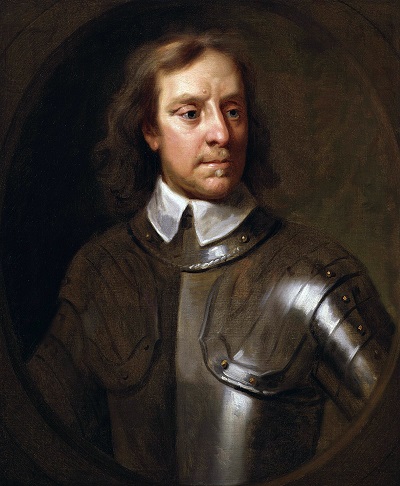Oliver Cromwell, ‘Lord Protector’ of the British Isles and scourge of the monarchy, was publicly executed on this day in 1661, but it didn’t hurt… he’d been dead for over two years.
After helping lead the Parliamentarian “Roundheads” to victory in the English Civil Wars, Cromwell deposed the monarchy and was one of the signatories of King Charles I’s death warrant in 1649.
 For the next four years he dominated the republican ‘Commonwealth of England’ as the foremost member of its so-called ‘Rump Parliament’, before dismissing its other members by force. He then became Lord Protector of England (which included Wales at the time), Scotland and Ireland from December 1653 until his death from natural causes on September 3rd, 1658, at the age of 59.
For the next four years he dominated the republican ‘Commonwealth of England’ as the foremost member of its so-called ‘Rump Parliament’, before dismissing its other members by force. He then became Lord Protector of England (which included Wales at the time), Scotland and Ireland from December 1653 until his death from natural causes on September 3rd, 1658, at the age of 59.
Cromwell wielded such individual power that his death also sounded the death knell for his ideal of a British republic, free from a ruling monarchy. The public who once supported him had also quickly tired of his strict puritan rule. When the Royalists were returned to power in 1660 and put Charles II on the throne, they had a score to settle – and they weren’t about to let the fact that Cromwell was already dead get in their way.
In a show of near-farcical revenge, they dug up the bodies of Cromwell and two of his deceased comrades and subjected them to a posthumous public ritual execution. The date of January 30th was probably chosen for this bizarre spectacle as it also marked the anniversary of Charles I’s execution.
The bodies were dragged through the streets of London to the public gallows at Tyburn, where they were hanged for most of the day. At 4pm they were taken down, the heads cut off and the bodies dumped unceremoniously into a pit.
Incidentally, a far worse fate befell 12 surviving ‘regicides’ – those living Parliamentarians who participated in the trial and execution of Charles I. After their trial and conviction, they were sentenced to be ‘hanged, drawn and quartered’ – a truly horrific and excruciating form of execution best not described in detail here! (If you really want to know, and have a strong stomach, click here.)
After the ritual execution of Cromwell’s embalmed corpse, his severed head was displayed on a 20ft wooden spike outside Westminster Hall for the next 24 years, until 1685 when a violent storm snapped the spike and brought his bonce tumbling down. Even after that it changed hands many times, bought and sold for public display. It wasn’t reburied until 1960, more than 300 years after Cromwell’s death, with the exact location not disclosed in case it was dug up again!
Centuries after his death, Cromwell remains perhaps the most controversial and divisive figure in British history. In a 2002 public poll he was selected as one of the 10 greatest Britons of all time, yet the winner of that same poll, Sir Winston Churchill, considered Cromwell a military dictator motivated largely by religious fervour and his own lust for power.
He remains revered by many who consider him a revolutionary hero and father of true democracy, and a statue stands proudly outside the House of Commons. Yet he is reviled by others, not least in Ireland where his persecution of the Catholics was near-genocidal.
He died an all-powerful ruler, but after death his remains were subjected to ignominy. Even then he may have had the last laugh, as many historians cast doubt on whether the body dug up and mutilated by the Royalists was actually his.
They speculate that his friends had already disposed of his body privately and secretly, either before or shortly after the state funeral at Westminster Abbey, to protect it from vengeful Royalists. The ‘body’ used in the funeral was actually a wooden effigy, since the ceremony took place more than two months after Cromwell’s death and the corpse was unfit to ‘lie in state’ on public display. Various stories suggest Cromwell’s real remains lie undisturbed in either London, Cambridgeshire, Northamptonshire, Yorkshire or at the bottom of the deepest part of the River Thames.
